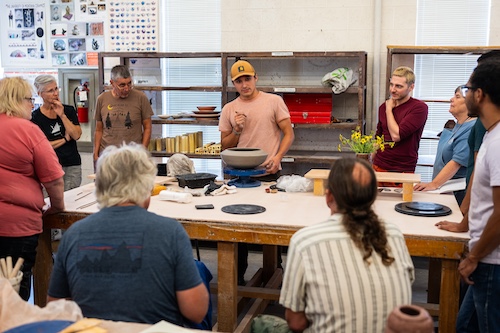 Diné artist Jared Tso led a workshop at WNMU as part of the annual Silver City CLAY Festival, which was held July 22-28, 2024. Founded in 2011, the CLAY Festival features workshops, exhibitions, artists' talks and moreSILVER CITY, NM – Since its founding in 2011, the Silver City CLAY Festival has offered events and activities for experienced ceramicists as well as those completely new to clay. One of the highlights of this year's festival was a WNMU-hosted workshop with Diné artist Jared Tso.
Diné artist Jared Tso led a workshop at WNMU as part of the annual Silver City CLAY Festival, which was held July 22-28, 2024. Founded in 2011, the CLAY Festival features workshops, exhibitions, artists' talks and moreSILVER CITY, NM – Since its founding in 2011, the Silver City CLAY Festival has offered events and activities for experienced ceramicists as well as those completely new to clay. One of the highlights of this year's festival was a WNMU-hosted workshop with Diné artist Jared Tso.
Tso, who comes from a family of Navajo ceramicists, led participants in an exploration of traditional clay practices that included digging clay at NAN Ranch in the Mimbres Valley, learning forming techniques such as pinching and coiling, and pit firing.
Now based in northeastern Arizona, Tso grew up in eastern Washington, and has been in the southwest since 2014. He came to New Mexico to get his undergraduate degree in electrical engineering from UNM and worked as an engineer for several years. "I did clay in the background during that time," he said, "and I started doing so many shows—and doing so much work after work—that I decided to go back for an MFA."
While his art has evolved over time, there are certain things that unite his pieces. "One of the through lines," he said, "is I make pots that have some sort of landscape representation to counter the narrative that we know from landscape paintings of the American West. I use clay as a way to counteract the stories that were told about our relationship to land, to each other, to world building."
A particularly important professional experience for Tso in recent years was spending time as a visiting artist at the Archie Bray Foundation for Ceramic Arts in Montana. The Bray has an Indigenous pit firing site and programming on Indigenous ceramics, called "First Fire." "First Fire" allowed Tso to gather with other Native ceramic artists to discuss the complex ethical questions surrounding the sharing of Indigenous artistic practices.
Those conversations have informed his approach to teaching the workshop at CLAY Festival. Tso said that he was trying to encourage workshop participants to bring their own experiences into their use of traditional techniques while also trying to facilitate conversations that encouraged ethical practices. "The last thing I want to do as a native artist is to share what I do and then have non-native people make Navajo pots."
Tso said the workshop had been fast paced. "I wanted to give students the full picture—digging clay, processing it, hand-building it and firing it," he said. "I wanted them to feel liberated from requiring intense facilities to have a relationship with clay."
One of the workshop participants, Silver City resident Amy Maule, who has been working in clay for about 25 years, said that what she appreciated about the workshop is the difference between Tso's techniques and those she has learned in other settings. "I have done similar techniques but not in the same way, not with the same attention to surface, so it is really neat learning a new approach."
Post-baccalaureate student Allison George also enjoyed the opportunity to learn new techniques. George, who was working on a petite espresso cup and saucer, said she was especially looking forward to learning a technique using piñon pitch that Tso had mentioned earlier in the week. "He said that there was a way to treat the burnished clay with piñon to seal the clay and flavor the coffee."
Another participant, Victoria Prejean, who is a BFA student at WNMU, said that because most of her work is wheel-thrown, she was out of practice with hand building, but the workshop has rekindled her interest, while also strengthening her skills with clay. Working with Tso, she said, has especially helped her make larger pieces with thinner walls. Referring to a large, partly finished vessel in front of her, Prejean said, "Usually I am scared to do big, but this one was so fun. With Jared's instructions, it has really been so easy to build it."










